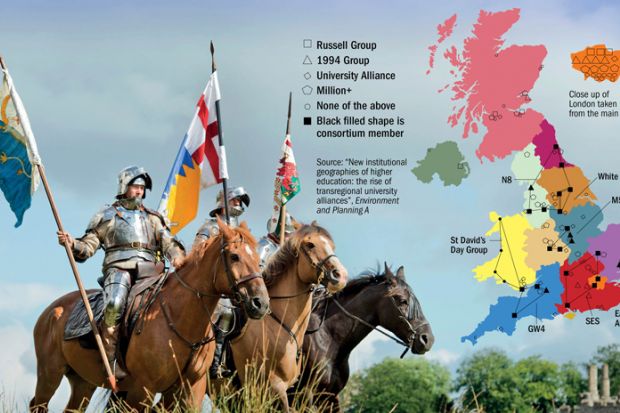View a high-resolution version
The creation of regional alliances has helped larger, more prestigious universities to “pull up the drawbridge” on research funding at the expense of modern institutions, a study claims.
The first major review of the UK’s seven research consortia, all but one of which have been founded since 2007, presents them as an attempt on the part of other Russell Group institutions to defend themselves against the growing dominance of the “golden triangle” of London and the universities of Oxford and Cambridge.
Academics at Loughborough University argue that the effect, in an increasingly competitive higher education sector, has been the further exclusion of post-92 institutions from research funding opportunities.
The first regional alliance, founded in 1997, was the White Rose University Consortium, comprising the universities of Leeds, Sheffield and York. These were also among eight northern institutions that set up what would become the N8 Research Partnership in 2007, and five Welsh universities established the St David’s Day Group two years later.
Four more consortia were formed between August 2012 and September 2013: the Midlands-based M5, the Great Western Four, Science and Engineering South (SES), and the Eastern Academic Research Consortium.
Writing in Environment and Planning A, John Harrison, Darren Smith and Chloe Kinton – senior lecturer, professor and research associate respectively in Loughborough’s department of geography – say that the formation of consortia has reflected “a desire to remake extant regions along more exclusive lines by identifying a set of elite universities”.
Eighteen out of 21 long-standing Russell Group members are part of an alliance, they say, whereas only six of the 14 members of the former 1994 Group of smaller research-intensive institutions are represented.
The University Alliance and Million+, whose members are newer universities, have no presence in consortia.
The Loughborough researchers say that consortia members have been responding to the growing dominance of golden triangle institutions in research funding. This is only possible “by having critical mass through partnerships”, one Russell Group interviewee told them.
The paper says that alliance institutions have also been responding to a government agenda that looks to reward collaborative research which is, in the words of a 2003 policy document, “more concentrated and better-managed”, as a way of maximising value for money and delivering efficiencies.
While this might appear to give universities control over their own destinies, the Loughborough trio say that less prestigious institutions are “quite often powerless” to join regional partnerships due to elite universities’ fear, in the words of one interviewee, that letting them join could “jeopardise” the group’s exclusive reputation.
The Loughborough trio highlight how some research alliances have reached agreements to collaborate on the formation of doctoral training centres, which attract research council funding, and argue that leading institutions are also creating new partnerships that span regions to secure more of these centres.
The authors cite university rankings as evidence for consortia’s role in growing inequality: they calculate that member institutions have improved their standing in The Complete University Guide table by an average of three and a half places since 2007, while non-member institutions have dropped by an average of four places.
The paper says that “a metaphorical drawbridge is being pulled up behind the larger research-intensive universities, as an ever-decreasing number of universities are able to compete at the top table in UK higher education”.
Pam Tatlow, chief executive of Million+, said that the study demonstrated how many regional alliances were “little more than consortia designed to ensure that research funding remains highly concentrated…aided and abetted in this objective by the criteria applied by the research councils”.
But Kieron Flanagan, senior lecturer in science and technology policy at the University of Manchester, said that the concentration of research funding had been “happening for decades” and that the results of the 2014 research excellence framework demonstrated that attempts to keep up with the golden triangle had failed; most consortia members were “rapidly losing ground” on Oxford, Cambridge and leading London institutions, Dr Flanagan said.
Peter Simpson, director of the N8, said that consortia were not defensive but aimed instead to “grow the pie”, using collaboration to create world-class research opportunities that were attractive for investors.
While this collaboration was fruitful, member universities often chose to work with other institutions if it was more suitable, he said.
POSTSCRIPT:
Print headline: Regional alliances ‘aid elites in funding war’
Register to continue
Why register?
- Registration is free and only takes a moment
- Once registered, you can read 3 articles a month
- Sign up for our newsletter
Subscribe
Or subscribe for unlimited access to:
- Unlimited access to news, views, insights & reviews
- Digital editions
- Digital access to THE’s university and college rankings analysis
Already registered or a current subscriber? Login




